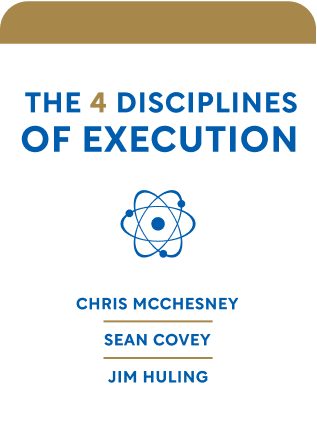

This article is an excerpt from the Shortform book guide to "The 4 Disciplines of Execution" by Chris McChesney, Sean Covey, and Jim Huling. Shortform has the world's best summaries and analyses of books you should be reading.
Like this article? Sign up for a free trial here .
Are you looking for some examples of The 4 Disciplines of Execution? What different settings can use the 4DX model?
The 4 Disciplines of Execution examples range in setting from production to climbing Everest. Each example provides insights into how the 4DX system works.
Read on for The 4 Disciplines of Execution examples and see how they might apply to your life and work.
The 4 Disciplines of Execution Examples
These examples of The 4 Disciplines of Execution in action include a water-bottling plant, a production plant, mountain-climbing teams, and NASA.
Water-Bottling Plant
Here’s an example of one company’s journey to find influenceable, predictive lead measures:
A water-bottling plant came up with the following WIG: “Increase bottling from 45 million gallons to 50 million gallons by the end of the year.”
At first, the company struggled to understand the difference between lead and lag measures. Their early suggestions for lead measures were to keep track of water production by day or month—these might be more frequently measured than the WIG result, but they’re still lag measures. Then, the production manager identified a problem that stopped the company from producing more water—the machines had too much downtime.
The next step was to translate the problem into a lead measure. They came up with: complete preventative maintenance on each machine once a week.
Water production increased at a rate faster than anyone expected. The plant had known that the factor they chose as a lead measure was important, but instead of focusing on only this factor, they’d been trying to tame the whole whirlwind at once. Their efforts were so spread out they had little effect on anything.
Production Plant
The second of The 4 Disciplines of Execution examples is about the effects of a scoreboard:
A Canadian plant hadn’t hit its target production number in 25 years. The plant was old and remote, their technology was outdated, and they had quality issues (low 70s compared to high 80s in the other companies’ plants). When the leaders put up a scoreboard, everything changed. People realized they were losing, and wanted to turn that around. The night shifts and day shifts competed to be more productive. Everyone knew each other and on the weekends, when they’d hang out and play hockey, they wanted to be able to brag about their shift doing better than the other. The plant’s quality score became the best in the company and the plant massively exceeded its production targets.
Climbing Everest
This example contrasts two mountain-climbing teams, one that respected Discipline 4, and one that didn’t.
Erik Weihenmayer’s Everest team had a “tent meeting” at the end of every day. When they encountered a problem while climbing during the day, they debriefed and discussed possible solutions in the evening. For example, the first time the team practiced the dangerous Khumbu Icefall feature, Weihenmayer took 13 hours to cross it. On summit day, the team would have to cross the feature in less than two hours. After some time, Weihenmayer was able to improve the speed. He made it to the top, as did most of his team members, and they set a record for the greatest number of people from a single team to summit in one day. They all returned safely.
Jon Krakauer’s Everest team didn’t have any method for regularly checking in with each other. They had no discipline or accountability. When the team encountered difficulties, some climbers set out on their own for the summit. Even though they had harnessed some of the first three disciplines, they didn’t employ Discipline 4, and the whole expedition was a failure. Eight people died.
The 4 Disciplines of Execution Examples at NASA
The final of the The 4 Disciplines of Execution examples is about the effectiveness of adhering to Discipline 1:
In 1958, NASA had seven very important goals along the lines of increasing human knowledge about space, improving spaceships, long-range studies, positioning the US in the space race, military applications, and cooperation with other nations. Some of these goals were measurable, but none of them had a deadline.
In 1961, J.F. Kennedy gave NASA a WIG in the correct “from point A to point B by deadline” format: put a man on the moon and bring him back before 1970.
There were three lower-level “battle” WIGs to support Kennedy’s “war” WIG:
- Get a spacecraft to the right position on the moon, keeping in mind that the moon is moving in orbit.
- Find a way to power rockets carrying heavy lunar modules fast enough to break free of Earth’s gravity.
- Develop a capsule and landing gear that would keep a person alive both in transit to and from, and while on, the moon.
When Kennedy announced his WIG, accountability, morale, and engagement at NASA exponentially increased. At the time, NASA didn’t have the technology to achieve any of the three “battle” WIGs, but they got it done—Neil Armstrong walked on the moon in 1969.
(Kennedy was also a good example of saying no to good ideas. He was asked why he chose to focus on man-on-the-moon instead of other worthy goals, and he said this goal was most important.)

———End of Preview———
Like what you just read? Read the rest of the world's best book summary and analysis of Chris McChesney, Sean Covey, and Jim Huling's "The 4 Disciplines of Execution" at Shortform .
Here's what you'll find in our full The 4 Disciplines of Execution summary :
- The 4 disciplines that can make any strategy a successful reality
- Why a great plan falls apart when you don't think adequately about execution
- The 6 steps you need to scale the 4DX model across an entire organization






